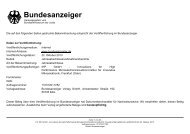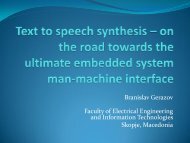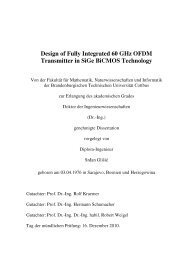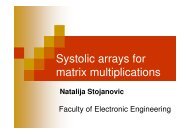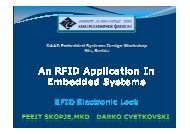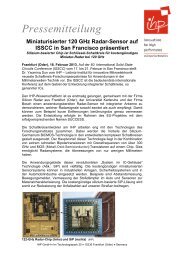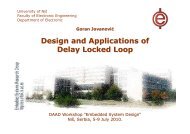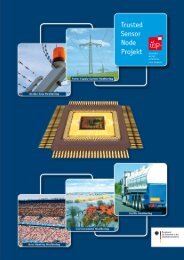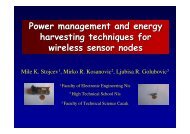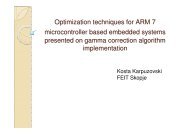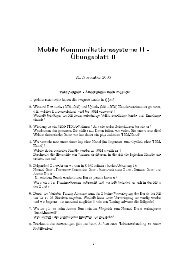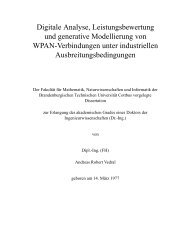Mobile Communications I - IHP Microelectronics
Mobile Communications I - IHP Microelectronics
Mobile Communications I - IHP Microelectronics
You also want an ePaper? Increase the reach of your titles
YUMPU automatically turns print PDFs into web optimized ePapers that Google loves.
Administrative Issues Lecture datesBasically bi-weekly15 semester weeks -> 7 lectures Dates: 2.4., 16.4., 7.5., 21.5. 11.6.,18.6., 2.7. 11:30-13:00 --- 13:45- 15:15 Room LG3A, R324 Execise dates Also bi-weekly Normally shifted one week fromlecture 5 exercices Dates: 23.4., 14.5., 4.6., 25.6., 9.7. 11:30-13:00 Room LG3A, R324 Exams Written Oral examinations on exception 16.7. - 28.7. Fail -> written Credits 6 Slides lecture and exercisesOne week before on www-serverOther issuesProvide name, email, tel. Matr.-Nr.,study, major, exam intention / Schein If you just need a participationcertificateyou need to participate in6 lectures4 execises Exceptions apply only on requestDr.-Ing. Jean-Pierre Ebert MC-I SS07 1.3
LiteratureLecture is mainly based on Jochen SchillerProf. Dr.-Ing.FU BerlinKnown for his ScatterWeb sensor nodesJochen Schiller: MobilkommunikationAddison-Wesley ISBN 3-8273-7060-4Matthew Gast: 802.11 Wireless NetworksO‘Reilly ISBN 0-596-00183-5 Bernhard Walke: Mobilfunknetze und ihre Protokolle Band 1Teubner Verlag ISBN 3-519-06430-8 Bernhard Walke: Mobilfunknetze und ihre Protokolle Band 2Teubner Verlag ISBN 3-519-06431-6 Additional readings provided per lect ureDr.-Ing. Jean-Pierre Ebert MC-I SS07 1.4
Chapter 1:Introduction A case for mobility – many aspects History of mobile communication Market Areas of researchDr.-Ing. Jean-Pierre Ebert MC-I SS07 1.5
Computers for the next decades?Computers are integrated small, cheap, portable, replaceable - no more separate devicesTechnology is in the background computer are aware of their environment and adapt (“location awareness”) computer recognize the location of the user and react appropriately (e.g.,call forwarding, fax forwarding, “context awareness”))Advances in technology more computing power in smaller devices flat, lightweight displays with low power consumption new user interfaces due to small dimensions more bandwidth per cubic meter multiple wireless interfaces: wireless LANs, wireless WANs, regionalwireless telecommunication networks etc. („overlay networks“)Dr.-Ing. Jean-Pierre Ebert MC-I SS07 1.6
<strong>Mobile</strong> communicationTwo aspects of mobility: user mobility: users communicate (wireless) “anytime, anywhere, withanyone” device portability: devices can be connected anytime, anywhere to thenetworkWireless vs. mobile Examples stationary computer notebook in a hotel wireless LANs in historic buildings Personal Digital Assistant (PDA)The demand for mobile communication creates the need forintegration of wireless networks into existing fixed networks: local area networks: standardization of IEEE 802.11,ETSI (HIPERLAN) Internet: <strong>Mobile</strong> IP extension of the internet protocol IP wide area networks: e.g., internetworking of GSM and ISDNDr.-Ing. Jean-Pierre Ebert MC-I SS07 1.7
Applications IVehicles transmission of news, road condition, weather, music via DAB personal communication using GSM position via GPS local ad-hoc network with vehicles close-by to prevent accidents, guidancesystem, redundancy vehicle data (e.g., from busses, high-speed trains) can be transmitted inadvance for maintenanceEmergencies early transmission of patient data to the hospital, current status, firstdiagnosis replacement of a fixed infrastructure in case of earthquakes, hurricanes,fire etc. crisis, war, ...Dr.-Ing. Jean-Pierre Ebert MC-I SS07 1.8
<strong>Mobile</strong> and wireless services – Always Best ConnectedDSL/ WLAN3 Mbit/sGSM/GPRS 53 kbit/sBluetooth 500 kbit/sUMTS, GSM115 kbit/sLAN100 Mbit/s,WLAN54 Mbit/sUMTS2 Mbit/sGSM/EDGE 384 kbit/s,DSL/WLAN 3 Mbit/sGSM 115 kbit/s,WLAN 11 Mbit/sUMTS, GSM384 kbit/sDr.-Ing. Jean-Pierre Ebert MC-I SS07 1.9
Applications IITravelling salesmen direct access to customer files stored in a central location consistent databases for all agents mobile officeReplacement of fixed networks remote sensors, e.g., weather, earth activities flexibility for trade shows LANs in historic buildingsEntertainment, education, ... outdoor Internet access intelligent travel guide with up-to-datelocation dependent information ad-hoc networks formulti user gamesHistoryInfoDr.-Ing. Jean-Pierre Ebert MC-I SS07 1.10
Location dependent servicesLocation aware services what services, e.g., printer, fax, phone, server etc. exist in the localenvironmentFollow-on services automatic call-forwarding, transmission of the actual workspace to thecurrent locationInformation services „push“: e.g., current special offers in the supermarket „pull“: e.g., where is the Black Forrest Cherry Cake?Support services caches, intermediate results, state information etc. „follow“ the mobiledevice through the fixed networkPrivacy who should gain knowledge about the locationDr.-Ing. Jean-Pierre Ebert MC-I SS07 1.11
<strong>Mobile</strong> devicesPager• receive only• tiny displays• simple textmessagesPDA• graphical displays• character recognition• simplified WWWLaptop/Notebook• fully functional• standard applicationsSensors,embeddedcontrollerswww.scatterweb.net<strong>Mobile</strong> phones• voice, data• simple graphical displaysperformancePalmtop• tiny keyboard• simple versionsof standard applicationsDr.-Ing. Jean-Pierre Ebert MC-I SS07 1.12
Effects of device portabilityPower consumption limited computing power, low quality displays, small disks due tolimited battery capacity CPU: power consumption ~ CV 2 fLoss of data C: internal capacity, reduced by integration V: supply voltage, can be reduced to a certain limit f: clock frequency, can be reduced temporally higher probability, has to be included in advance into the design(e.g., defects, theft)Limited user interfaces compromise between size of fingers and portability integration of character/voice recognition, abstract symbolsLimited memory limited value of mass memories with moving parts flash-memory or ? as alternativeDr.-Ing. Jean-Pierre Ebert MC-I SS07 1.13
Wireless networks in comparison to fixed networksHigher loss-rates due to interference emissions of, e.g., engines, lightningRestrictive regulations of frequencies frequencies have to be coordinated, useful frequencies are almost alloccupiedLow transmission rates local some Mbit/s, regional currently, e.g., 53kbit/s with GSM/GPRSHigher delays, higher jitter connection setup time with GSM in the second range, several hundredmilliseconds for other wireless systemsLower security, simpler active attacking radio interface accessible for everyone, base station can be simulated,thus attracting calls from mobile phonesAlways shared medium secure access mechanisms importantDr.-Ing. Jean-Pierre Ebert MC-I SS07 1.14
Early history of wireless communicationMany people in history used light for communication heliographs, flags („semaphore“), ...150 BC smoke signals for communication;(Polybius, Greece)1794, optical telegraph, Claude ChappeHere electromagnetic waves areof special importance: 1831 Faraday demonstrates electromagnetic induction J. Maxwell (1831-79): theory of electromagnetic Fields, wave equations(1864) H. Hertz (1857-94): demonstrateswith an experiment the wave characterof electrical transmission through space(1888, in Karlsruhe, Germany, at thelocation of today’s University of Karlsruhe)Dr.-Ing. Jean-Pierre Ebert MC-I SS07 1.15
History of wireless communication I1896 Guglielmo Marconi first demonstration of wirelesstelegraphy (digital!) long wave transmission, hightransmission power necessary (> 200kw)1907 Commercial transatlantic connections huge base stations(30 100m high antennas)1915 Wireless voice transmission New York - San Francisco1920 Discovery of short waves by Marconi reflection at the ionosphere smaller sender and receiver, possible due to the invention of the vacuumtube (1906, Lee DeForest and Robert von Lieben)1926 Train-phone on the line Hamburg - Berlin wires parallel to the railroad trackDr.-Ing. Jean-Pierre Ebert MC-I SS07 1.16
History of wireless communication II1928 many TV broadcast trials (across Atlantic, color TV, TV news)1933 Frequency modulation (E. H. Armstrong)1958 A-Netz in Germany analog, 160MHz, connection setup only from the mobile station, nohandover, 80% coverage, 1971 11000 customers1972 B-Netz in Germany analog, 160MHz, connection setup from the fixed network too (butlocation of the mobile station has to be known) available also in A, NL and LUX, 1979 13000 customer in D1979 NMT at 450MHz (Scandinavian countries)1982 Start of GSM-specification goal: pan-European digital mobile phone system with roaming1983 Start of the American AMPS (Advanced <strong>Mobile</strong> PhoneSystem, analog)1984 CT-1 standard (Europe) for cordless telephonesDr.-Ing. Jean-Pierre Ebert MC-I SS07 1.17
History of wireless communication III1986 C-Netz in Germany analog voice transmission, 450MHz, hand-over possible, digitalsignaling, automatic location of mobile device Was in use until 2000, services: FAX, modem, X.25, e-mail, 98%coverage1991 Specification of DECT Digital European Cordless Telephone (today: Digital EnhancedCordless Telecommunications) 1880-1900MHz, ~100-500m range, 120 duplex channels, 1.2Mbit/sdata transmission, voice encryption, authentication, up to several10000 user/km 2 , used in more than 50 countries1992 Start of GSM in D as D1 and D2, fully digital, 900MHz, 124 channels automatic location, hand-over, cellular roaming in Europe - now worldwide in more than 200 countries services: data with 9.6kbit/s, FAX, voice, ...Dr.-Ing. Jean-Pierre Ebert MC-I SS07 1.18
History of wireless communication IV1994 E-Netz in Germany GSM with 1800MHz, smaller cells As Eplus in D (1997 98% coverage of the population)1996 HiperLAN (High Performance Radio Local Area Network) ETSI, standardization of type 1: 5.15 - 5.30GHz, 23.5Mbit/s recommendations for type 2 and 3 (both 5GHz) and 4 (17GHz) as wirelessATM-networks (up to 155Mbit/s)1997 Wireless LAN - IEEE802.11 IEEE standard, 2.4 - 2.5GHz and infrared, 2Mbit/s already many (proprietary) products available in the beginning1998 Specification of GSM successors for UMTS (Universal <strong>Mobile</strong> Telecommunication System) as Europeanproposals for IMT-2000Iridium 66 satellites (+6 spare), 1.6GHz to the mobile phoneDr.-Ing. Jean-Pierre Ebert MC-I SS07 1.19
History of wireless communication V1999 Standardization of additional wireless LANs IEEE standard 802.11b, 2.4-2.5GHz, 11Mbit/s Bluetooth for piconets, 2.4Ghz,
Wireless systems: Overview of the development1981:NMT 4501986:NMT 900cellular phones1992:GSM1994:DCS 18001991:CDMA1983:AMPS1991:D-AMPS1993:PDC1982:Inmarsat-A1988:Inmarsat-Csatellites1992:Inmarsat-BInmarsat-M1998:Iridiumcordlessphones1980:CT01984:CT11987:CT1+1989:CT 2wireless LAN1991:DECT 199x:proprietary1997:IEEE 802.111999:802.11b, Bluetoothanalogue2000:GPRS2001:IMT-20002000:IEEE 802.11adigital4G – fourth generation: when and how?200?:Fourth Generation(Internet based)Dr.-Ing. Jean-Pierre Ebert MC-I SS07 1.21
Foundation: ITU-R - Recommendations for IMT-2000M.687-2 IMT-2000 concepts and goalsM.816-1 framework for servicesM.817 IMT-2000 network architecturesM.818-1 satellites in IMT-2000M.819-2 IMT-2000 for developing countriesM.1034-1 requirements for the radiointerface(s)M.1035 framework for radio interface(s) andradio sub-system functionsM.1036 spectrum considerationsM.1078M.1079M.1167M.1168M.1223M.1224M.1225. . .security in IMT-2000speech/voiceband data performanceframework for satellitesframework for managementevaluation of security mechanismsvocabulary for IMT-2000evaluation of transmission technologieshttp://www.itu.int/imtDr.-Ing. Jean-Pierre Ebert MC-I SS07 1.22
Worldwide wireless subscribers (old prediction 1998)700600500400300200AmericasEuropeJapanotherstotal10001996 1997 1998 1999 2000 2001Dr.-Ing. Jean-Pierre Ebert MC-I SS07 1.23
<strong>Mobile</strong> phones per 100 people 1999GermanyGreeceSpainBelgiumFranceNetherlandsGreat BritainSwitzerlandIrelandAustriaPortugalLuxemburgItalyDenmarkNorwaySwedenFinland0 10 20 30 40 50 602005: 70-90% penetration in Western EuropeDr.-Ing. Jean-Pierre Ebert MC-I SS07 1.24
Worldwide cellular subscriber growth12001000Subscribers [million]80060040020001992 1993 1994 1995 1996 1997 1998 1999 2000 2001 2002Note that the curve starts to flatten in 2000 – 2004: 1.5 billion usersDr.-Ing. Jean-Pierre Ebert MC-I SS07 1.25
Cellular subscribers per region (June 2002)Middle East;1,6Africa; 3,1Americas (incl.USA/Canada);22Asia Pacific;36,9Europe; 36,42004: 715 million mobile phones deliveredDr.-Ing. Jean-Pierre Ebert MC-I SS07 1.26
<strong>Mobile</strong> statistics snapshot (09/2002 / 12/2004)Total Global <strong>Mobile</strong> Users869M / 1.52bnTotal Analogue Users 71M / 34mTotal US <strong>Mobile</strong> users 145M / 140mTotal Global GSM users 680M / 1.25TTotal Global CDMA Users 127M / 202mTotal TDMA users 84M / 120mTotal European users 283M / 343mTotal African users 18.5M / 53mTotal 3G users 130M / 130m(?)Total South African users 13.2m / 19mEuropean Prepaid Penetration 63%European <strong>Mobile</strong> Penetration 70.2%Global Phone Shipments 2001 393mGlobal Phone Sales 2Q02 96.7mhttp://www.cellular.co.za/stats/statsmain.htm#1 <strong>Mobile</strong> Country China (139M / 300m)#1 GSM Country China (99m)#1 SMS Country Philipines#1 Handset Vendor 2Q02 Nokia (37.2%)#1 Network In Africa Vodacom (6.6m)#1 Network In Asia Unicom (153m)#1 Network In Japan DoCoMo#1 Network In Europe T-<strong>Mobile</strong> (22m / 28m)#1 In Infrastructure EricssonSMS Sent Globally 1Q02 60T / 135bnSMS sent in UK 6/02 1.3T / 2.1bnSMS sent Germany 1Q02 5.7TGSM Countries on Air 171 / 210GSM Association members 574 / 839Total Cost of 3G Licenses in Europe 110TSMS/month/user 36The figures vary a lot depending on the statistic, creator of the statistic etc.!Dr.-Ing. Jean-Pierre Ebert MC-I SS07 1.27
Areas of research in mobile communicationWireless Communication Architectures transmission quality (bandwidth, error rate, delay) modulation, coding, interference media access, regulations ...Mobility location dependent services location transparency quality of service support (delay, jitter, security) ...Portability energy efficiency limited computing power, sizes of display, ... usability ...Dr.-Ing. Jean-Pierre Ebert MC-I SS07 1.28
Wireless Internet ChallengesAttribute Now Needed ChallengesBandwidth 9.6 Kb/s 20-50 Mb/s 1000x140Kb/s GPRS 1Gb/s planned 10000Processing 100 MIPS 10,000 MIPS 100xPower 1 mW/MIPS 0.01 mW/MIPS 100xconsumptionNo. of chips 10-50 1 Not possible at presentForm factor Brick Single chip Internal comms., PowerDistributed distr., PackageSoftware Win Ce, PalmOS Java/Jini HW independent SWServices VOICE+ data TRANSACTIONS +DATA + voiceIntegrated, seamless,secureFeatures Undifferentiated Location, Context Need platformEnvironment awareCost $299 $99 Margin too low forservice pricingDr.-Ing. Jean-Pierre Ebert MC-I SS07 1.29
Simple reference model used hereApplicationApplicationTransportTransportNetworkNetworkNetworkNetworkData LinkData LinkData LinkData LinkPhysicalPhysicalPhysicalPhysicalRadioMediumDr.-Ing. Jean-Pierre Ebert MC-I SS07 1.30
Influence of mobile communication to the layer modelApplication layerTransport layerNetwork layerData link layerPhysical layer service location new applications, multimedia adaptive applications congestion and flow control quality of service addressing, routing,device location hand-over authentication media access multiplexing media access control encryption modulation interference attenuation frequencyDr.-Ing. Jean-Pierre Ebert MC-I SS07 1.31
Overlay Networks - the global goalintegration of heterogeneous fixed andmobile networks with varyingtransmission characteristicsregionalverticalhandovermetropolitan areacampus-basedhorizontalhandoverin-houseDr.-Ing. Jean-Pierre Ebert MC-I SS07 1.32



